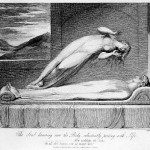
(Wikimedia Commons public domain image)
I’m something of a fan of the Claremont philosopher Stephen T. Davis, who is a believing Christian. Here are some passages that I’ve marked in his book After We Die: Theology, Philosophy, and the Question of Life after Death (Waco: Baylor University Press, 2015. He’s talking about the period between death and resurrection:
Temporary disembodiment is the theory that strikes me, as it has struck most theologians in Christian history, as the most plausible. (60)
This happens to be what is taught at Alma 40:11-15, and elsewhere.
The state of being without a body is an abnormal state of the human person. This is one of the clear differences between temporary disembodiment and immortality of the soul, for the second doctrine (at least in versions of it influenced by Plato) entails that disembodiment is the true or proper or best state of the human person. On the theory we are considering, however, the claim is that a disembodied soul lacks many of the properties and abilities that are normal for and proper to human persons. Disembodied existence is a kind of minimal existence. (61)
Aquinas argued that the disembodied existence of the person in the interim state is so deficient that attainment of ultimate happiness is impossible. No one who lacks some perfection is perfectly happy, for in such a state there will always be unfulfilled desires. It is contrary to the nature of the soul to be without the body, Aquinas says. He takes this to mean both that the disembodied state must only be temporary, and that the true bliss of the human person is only attained after re-embodiment, that is, in the general resurrection. He says, “Man cannot achieve his ultimate happiness unless the soul be once again united to the body.” (62)
I’m reminded in this context of the words of President Joseph F. Smith, recounting his great October 1918 Vision of the Redemption of the Dead, that “the dead had looked upon the long absence of their spirits from their bodies as a bondage” (Doctrine and Covenants 138:50).
The Fathers and scholastics insisted . . . that both body and soul must be present or else the person, the human being, does not exist in the fullest sense. If only the soul survives, the person survives only in a truncated and bare sense. Thus Athenagoras wrote, “A man cannot be said to exist as such when the body is dissolved or completely scattered, even though the soul remain by itself.” And Aquinas agreed: “My soul is not I, and if only souls are saved, I am not saved, nor is any man.” Thus the real Christian hope of survival is not the hope that our souls will survive death (though on temporary disembodiment that is one important aspect of it), but rather the hope that one day God will miraculously raise our bodies and reunite them with our souls. (63)
The eminent English New Testament scholar N. T. Wright, reacting to the emphasis that some, including Christians, put on near-death experiences and on the hope that they support of sheer immortality, likes to remind his audiences that the full promise of Christianity isn’t merely survival of death but what he calls “life after life after death” — which is to say, fully resurrected life in a redeemed community of the redeemed.













